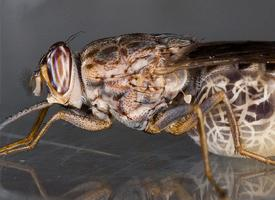
Statut de conservation
| Intrépide |
Description de l'animal
The Tsetse fly, scientifically known as Glossina, is a genus of bloodsucking flies indigenous to the African continent. These flies are significant both ecologically and medically, as they are primary vectors for the transmission of trypanosomiasis, commonly known as sleeping sickness in humans, and Nagana in animals. The disease is caused by parasitic protozoans of the genus Trypanosoma. Tsetse flies are unique to the African region and are found across sub-Saharan countries, thriving in a wide range of environments from lush rainforests to arid savannahs.Morphologically, Tsetse flies resemble other biting flies but are distinguishable by certain key features. They are relatively large, measuring about 0.5 to 1.5 centimeters in length. One of the most distinctive characteristics of Tsetse flies is their forward-projecting proboscis, which they use to pierce the skin of their hosts and suck blood. Their wings are another unique trait; when at rest, Tsetse flies fold their wings completely one over the other over their back, a feature not seen in similar flies.
The life cycle of the Tsetse fly is quite extraordinary and differs significantly from that of other bloodsucking flies. Tsetse flies are viviparous, meaning they give birth to live young. The female fly nurtures a single larva at a time inside her body, feeding it with a milk-like substance secreted by a special gland. After a development period of about nine days, the larva is deposited in a shaded area where it burrows into the soil and pupates. The pupal stage lasts for several weeks to a few months, depending on environmental conditions. Upon emerging from the pupal case, the adult fly is fully developed and ready to begin its life cycle.
Tsetse flies are opportunistic feeders, preying on the blood of vertebrate animals, including humans, livestock, and wild animals. This feeding behavior is central to the transmission of the trypanosomes that cause disease. The flies become infected with trypanosomes when they feed on the blood of an infected host. The parasites then multiply within the fly's midgut and eventually migrate to the salivary glands, from where they can be transmitted to a new host during subsequent feedings.
Control and eradication efforts for Tsetse flies have been ongoing for many years, utilizing various methods including trapping, insecticide spraying, and the sterile insect technique. These efforts are crucial for the health and economic well-being of affected regions, as trypanosomiasis poses a significant barrier to the development of sustainable agriculture and livestock rearing in Africa.
In summary, the Tsetse fly (Glossina) is a fascinating yet dangerous insect, notorious for its role in spreading the deadly sleeping sickness. Its unique biology and ecological significance make it a subject of extensive study, particularly in the fields of entomology, parasitology, and tropical medicine.
Nouvelles photos d'animaux
Top 10 des animaux
- Dolphin gull (Leucophaeus scoresbii)
- Diana monkey (Cercopithecus diana)
- Moustached guenon (Cercopithecus cephus)
- Galápagos tortoise (Geochelone nigra complex)
- Russian tortoise (Testudo horsfieldii)
- Japanese macaque (Macaca fuscata)
- Stone loach (Barbatula barbatula)
- Greek tortoise (Testudo graeca)
- Common flying dragon (Draco volans)
- Colossal squid (Mesonychoteuthis hamiltoni)